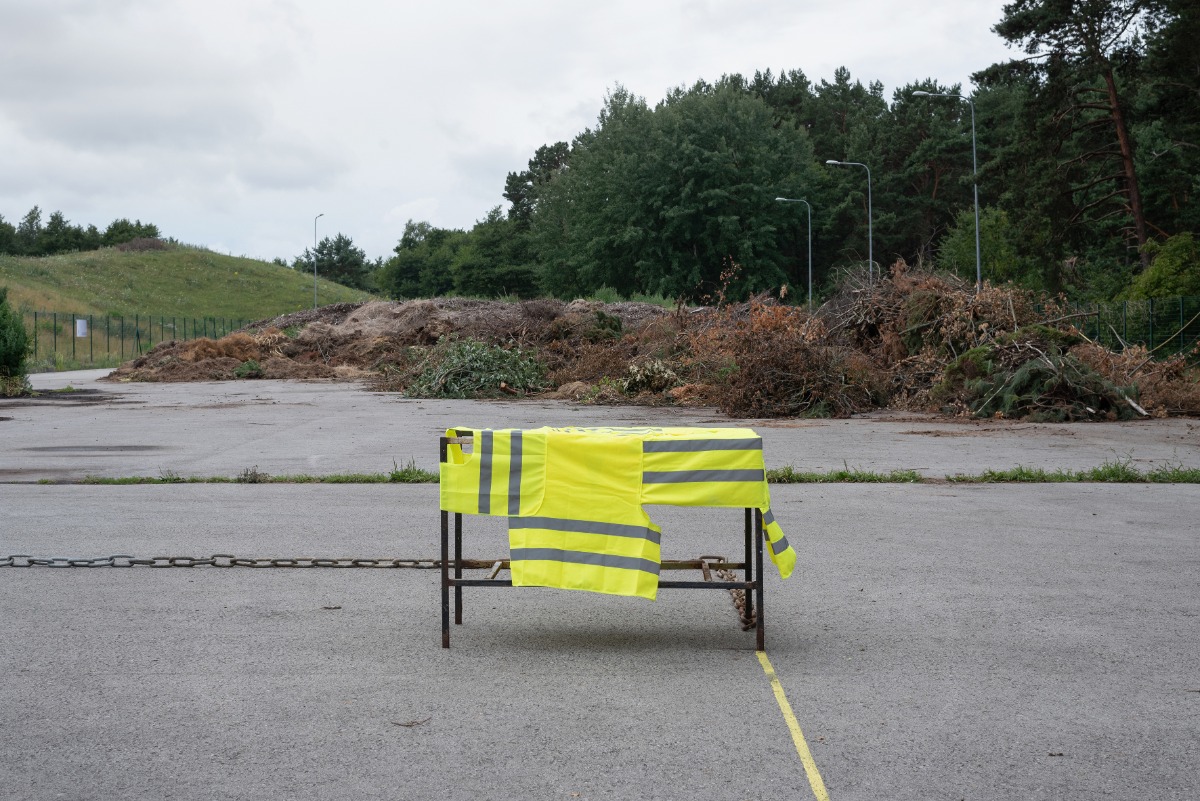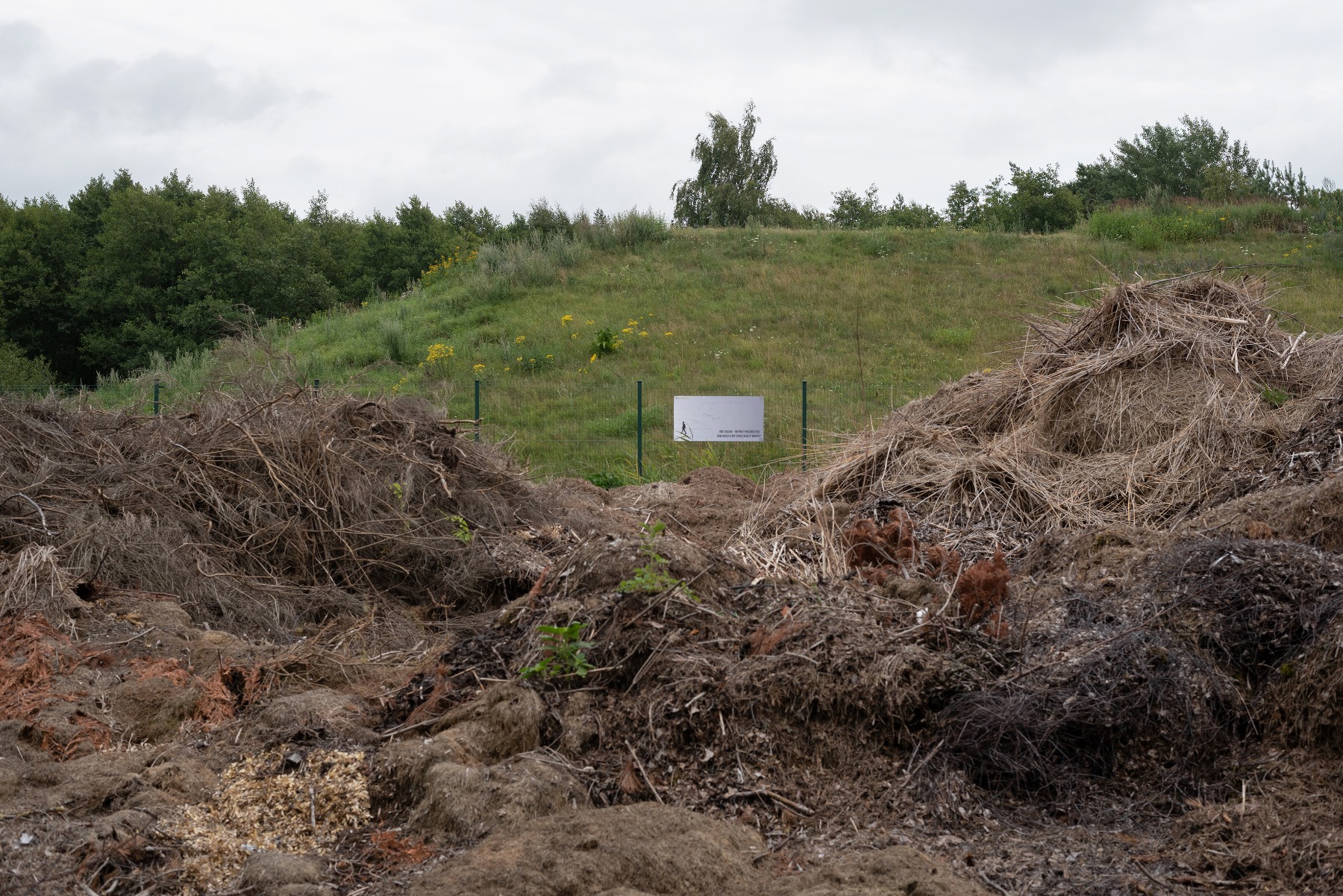
Wrestling with an obsession
Notes on Obsession and Nida
Over the course of eleven weeks, from the high season of the Baltic summer to the first moments of an unmistakable fall, Nida Art Colony hosted Obsession – a two-part group exhibition conceived and curated by Lithuanian artist Anastasia Sosunova. Spanning across two sites separated by a short car drive – Nida Art Colony’s exhibition venue and the waste collection site “UAB KRATC” – Obsession is equal parts driven/informed by the uniquely positioned resort town trapped on a skinny land strip of the Curonian Spit as well as Sosunova’s own artistic-research practice as we know it so far. Open in her disinterest in complying with certain “rules” or expectations linked to the curatorial function, Sosunova has selected ten participants in total (individuals and a duo), and in attuned solidarity with them, has imagined and then executed an exhibition where works of art and everyday objects behave as relics – as defined by relations between bodies, substances, obsessions and touches.
Exhibition view: Obsession, 2023, KRATC waste collection site, Neringa. Photo: Lukas Mykolaitis
Exhibition view: Obsession, 2023, KRATC waste collection site, Neringa. Photo: Lukas Mykolaitis
In 2022, Sosunova first presented her 16-minute-long film “Coders”, which formed part of her ongoing research of the coding practice – a placebo-based stress-therapy addiction treatment method created by Soviet therapist Aleksandr Dovzhenko in 1984. Showing first-person footage gathered by the author, this video tells the story of how one is “coded” to stop smoking. Recounting a journey through streets, corridors, sessions, calls and meetings, as well as presenting archival footage and conversations with researchers, it aims to understand what it means to be “coded.” This piece (not included in the exhibition) seems apt/fit for a mention in an attempt to understand the inner workings that may have been in place, or have in some ways guided, Sosunova’s choice in favoring a decisive move aside/away from “coding” and towards “obsession”.
Exhibition view: Obsession, 2023, KRATC waste collection site, Neringa. Photo: Lukas Mykolaitis
Sosunova’s interest in note-making[1],conversations, and amassing a vast amount of reference data – at times turned into essays, performed, or read to an audience – must have planted fertile ground for an obsession-adjacent reasoning to announce itself. “Gathering the little pieces of the puzzles through which people and communities construct themselves, I am interested in secular rituals of identification – rituals and gestures that reflect a profound desire to discover passage or protection; a rational and, at the same time, magical action that would pave the way for a new life and new self perception”[2], she wrote in the small yet rigorous exhibition pamphlet “Express method”, published in relation to her solo show at Swallow in 2021.
For Obsession, Sosunova continues using the first person point of view in delivering her thoughts to an audience, in this way communicating the exhibition sites, artworks and artists themselves[3]. This “I, etc.” approach meanders between a feel of a letter, a report, or a confession, and interestingly, it is also what I, as a visitor, got from this intricately and intuitively built project.
Case, Sideworks: Nida, Lithuania, 2023 – ongoing, installation. Photo: Lukas Mykolaitis
Obsession starts with Neringa itself, a both seasonally touristic and militarily charged site cut off from the rest of the country. The life cycle here has a reactionary nature. Impacted by shifts in geopolitical as well as ecological conditions, Neringa’s permanent residents are increasingly vulnerable to a declining flow of tourists, who are hesitating to schedule visits either due to the nearby ongoing regional conflict or because of the chillier summers we’ve been lately experiencing – the cold is literally ruining businesses.
Case, Sideworks: Nida, Lithuania, 2023 – ongoing, installation. Photo: Lukas Mykolaitis
Obsession’s two locations – the conditional “center” and the “periphery” – inform both each other and the exhibition itself. Nida Art Colony, a site for art production and education, research, and rooms for rent[4], contrasts with Neringa municipality’s garage and recycling business operations at KRATC, a hoarder’s paradise and one of the few public places where you can actually meet Nida’s locals. In their research phase, Sosunova and the exhibition’s architect, artist Laura Kaminskaite, seem to have gone back and forth between the two. We observe as source materials, such as metal poles, are brought into the exhibition hall from KRATC, while the more conventional display mechanisms of video and installation art have been staged across the perimeter of the latter.
Zoe Leonard, This is where I was, reading text from the publication Zoe Leonard: You See I Am Here After All, 2010. Photo: Lukas Mykolaitis
With its participating artists hailing from across the region as well as places and contexts far away, Obsession features younger creative voices (the single exception being the more-established Zoe Leonard and her text piece, a compilation of messages found on postcards picturing Niagara Falls – yet another tourist attraction). Part of the artists have not long ago left their educational institutions, but some have already invested in cross-generational pairings and are working with up-to-date overlooked living archives (such as Mykolas Valentinas’ collaboration with folk artist Mečislovas Ežerskis). This is also the case with the works by Nijolė Vilutytė, which resonate as the methodological backbone of the exhibition and, moreover, served as a starting point and an impulse for Sosunova’s conception of the project.
Nijolė Vilutytė, Sketches for artworks in public architectural spaces, 1972–1990, drawings on tracing paper. Photo: Lukas Mykolaitis
Nijolė Vilutytė, Sketches for artworks in public architectural spaces, 1972–1990, drawings on tracing paper. Photo: Lukas Mykolaitis
Sosunova grew up in the town of Ignalina, known for the nearby but now defunct nuclear power plant with the same name. She spent a large portion of her time in the workshops and educational activities held at the local culture center, which is where she first encountered the murals made by Vilutytė, a painter and mural-maker whose career spans from the early 1970s commissions under the Soviet regime to the current day. For the past couple of years, Sosunova has been in contact with Vilutytė, who appears to have become “haunted” by a newly acquired force/drive to go after and monitor the condition of her public works that are scattered across the country.
Exhibition view: Obsession, 2023, Nida Art Colony, Nida. Photo: Lukas Mykolaitis
An understandable, and likable, obsession of an artist has become a headache for the developers who own these heritage mural pieces that are now “locked into” buildings that would otherwise not be listed as having heritage value. Vilutytė’s work in the exhibition’s section at Nida exhibition hall is presented through a series of drawings on tracing paper (1972-1990), displayed either between flat glass surfaces or taking a more sculptural shape by free-standing in a see-through box. These drawings serve as ghostly flashbacks from an ideologically charged past carrying undertones of systemic limitations and a game of compromise. Tied to its time, but also symptomatic of our current one, Vilutytė’s works made for publicly accessible communal spaces no longer receive a “free pass”.
Annika Eriksson, I am the dog that was always here (loop), 2013, video, 09:07. Photo: Lukas Mykolaitis
Another artwork that has been with Sosunova for some time is Annika Eriksson’s video “I am the dog that was always here” (2013), first encountered at Survival Kit 9. Resurrected from a decade ago, the video has found a fitting display context at KRATC, appearing as if it had been filmed in this concrete, semi-abandoned wasteland. Over the course of nine minutes, the camera registers a group of stray dogs running, playing and fighting with each other on a gradually changing backdrop of dusty pathways, ruins, and non-places. Constantly pushed away and outside of the city as the city itself deteriorates (is this a building site, or is it now a ruin?), the dogs always seem to find their way back into it. By taking their power back, they start to “speak”. A monotonous voice-over conveys seemingly prophetic messages, spoken on loop throughout the video: “Then it will be crowded again and then empty again”, “They lived here, then they disappeared and others came and disappeared, and now they are back,” always ending with: “But tomorrow they leave. Well, whatever, who cares.” The giving of space is conditional – that is what Eriksson’s work reminds us in Obsession.
Felix Kalmenson, The Second Opinion, 2016–2019, video, 24:50. Photo: Lukas Mykolaitis
Felix Kalmenson, 7.5% (Dybbuk), 2023, stage platforms, NAC housekeeping materials, framed digital prints on paper. Photo: Lukas Mykolaitis
Against a backdrop of aggression and injustice, issues such as anti colonial struggles, concerns of belonging, land ownership, and an act of resistance further permeate through a number of the works on display. Transgenerational trauma is embodied in Native American artist Fox Maxy’s lengthy video “Maat” (2020). Infused with California landscapes, its call for revenge is addressed through its secondary title: “What does it mean to come from somewhere?”, while the film itself actually screams the demand to give the land back – a demand for justice. Felix Kalmenson’s installation “7.5% (Dybbuk)” consists of make-shift benches displaying a set of neatly arranged domestic supplies from Nida Art Colony’s storage, and a framed fire escape plan with 7,5% of the exhibition hall marked with red pen. The underlying message here is a tragic personal family history during the Holocaust (destroyed lives, murdered knowledge, stolen and re-distributed intelligence), all the while dancing with a satirized and utopian quest towards restitution. The project very simply suggests that 7.5% (a net absence) of the current and all future Lithuanian pavilions at the Venice Biennial should be allocated to the Yiddish pavilion as a gesture of reconciliation and repair. Still an enduring horror and trauma for the Jewish people, as well as society at large, the Holocaust remains non-fungible.
Fox Maxy, Maat, 2020, video, 30:00. Photo: Lukas Mykolaitis
In 1992, one year before Obsession’s curator was born, the widely popular and spicy amber-colored fragrance known as Calvin Kein’s Obsession perfume stormed the Western world (at some later point, they came out with a self-referential scent titled Obsessed). Evoking “weak resistance”, obsession fluctuates between the modes of passive and calm, between the obsessed and the possessed. An otherwise positively charged impulse that, in this economy, makes you even more easily exploitable. “So what do you do? You wrestle!”[5]
Exhibition view: Obsession, 2023, Nida Art Colony, Nida. Photo: Lukas Mykolaitis
[1] “Maybe, gradually, my obsession with notes will direct me down a similar path to Quesalid”, quoted from: Anastasia Sosunova, Express Method, Swallow and Kabinetas, 2021, p. 37
[2] Ibid, p. 13.
[3] Exhibition text: https://nidacolony.lt/en/exhibitions/obsession
[4] “It is interesting to think about Nida Art Colony as a hotel first and foremost” (from a conversion with Anastasia Sosunova in Riga, September 2023)
[5] From a conversion with Anastasia Sosunova in Riga, September 2023